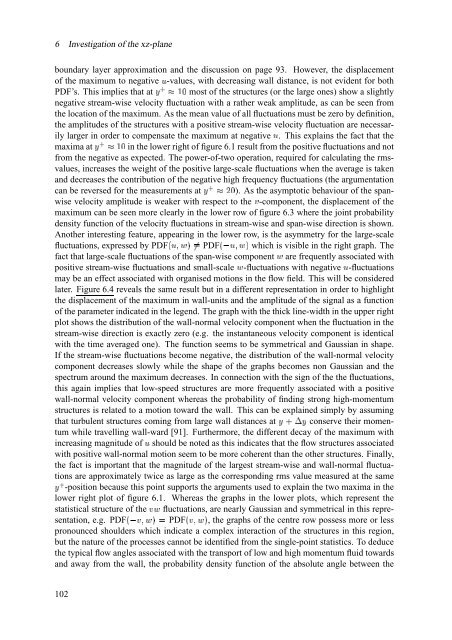The significance of coherent flow structures for the turbulent mixing ...
The significance of coherent flow structures for the turbulent mixing ...
The significance of coherent flow structures for the turbulent mixing ...
Create successful ePaper yourself
Turn your PDF publications into a flip-book with our unique Google optimized e-Paper software.
W<br />
<br />
<br />
M<br />
6 Investigation <strong>of</strong> <strong>the</strong> xz-plane<br />
boundary layer approximation and <strong>the</strong> discussion on page 93. However, <strong>the</strong> displacement<br />
<strong>of</strong> <strong>the</strong> maximum 6 to negative -values, with decreasing wall distance, is not evident <strong>for</strong><br />
þ¡<br />
both<br />
PDF’s. This implies u.v ; that at most <strong>of</strong> <strong>the</strong> <strong>structures</strong> (or <strong>the</strong> large ones) show a slightly<br />
negative stream-wise velocity fluctuation with a ra<strong>the</strong>r weak amplitude, as can be seen from<br />
<strong>the</strong> location <strong>of</strong> <strong>the</strong> maximum. As <strong>the</strong> mean value <strong>of</strong> all fluctuations must be zero by definition,<br />
<strong>the</strong> amplitudes <strong>of</strong> <strong>the</strong> <strong>structures</strong> with a positive stream-wise velocity fluctuation are necessarily<br />
larger in order to compensate <strong>the</strong> maximum 6 at negative . This explains <strong>the</strong> fact that <strong>the</strong><br />
in <strong>the</strong> lower right <strong>of</strong> figure 6.1 result from <strong>the</strong> positive fluctuations and not<br />
þ¡<br />
uv ;<br />
maxima at<br />
from <strong>the</strong> negative as expected. <strong>The</strong> power-<strong>of</strong>-two operation, required <strong>for</strong> calculating <strong>the</strong> rmsvalues,<br />
increases <strong>the</strong> weight <strong>of</strong> <strong>the</strong> positive large-scale fluctuations when <strong>the</strong> average is taken<br />
and decreases <strong>the</strong> contribution <strong>of</strong> <strong>the</strong> negative high frequency fluctuations (<strong>the</strong> argumentation<br />
can be reversed <strong>for</strong> <strong>the</strong> uv ; Ó measurements at ). As <strong>the</strong> asymptotic behaviour <strong>of</strong> <strong>the</strong> spanwise<br />
velocity amplitude is weaker with respect 7 to <strong>the</strong> -component, <strong>the</strong> displacement <strong>of</strong> <strong>the</strong><br />
maximum can be seen more clearly in <strong>the</strong> lower row <strong>of</strong> figure 6.3 where <strong>the</strong> joint probability<br />
density function <strong>of</strong> <strong>the</strong> velocity fluctuations in stream-wise and span-wise direction is shown.<br />
Ano<strong>the</strong>r interesting feature, appearing in <strong>the</strong> lower row, is <strong>the</strong> asymmetry <strong>for</strong> <strong>the</strong> large-scale<br />
fluctuations, expressed PDF{|6 PDF{Î6 t~} by which is visible in <strong>the</strong> right graph. <strong>The</strong><br />
fact that large-scale fluctuations <strong>of</strong> <strong>the</strong> span-wise t component are frequently associated with<br />
t‚}„ƒ<br />
positive stream-wise fluctuations and t small-scale -fluctuations with 6 negative -fluctuations<br />
may be an effect associated with organised motions in <strong>the</strong> <strong>flow</strong> field. This will be considered<br />
later. Figure 6.4 reveals <strong>the</strong> same result but in a different representation in order to highlight<br />
<strong>the</strong> displacement <strong>of</strong> <strong>the</strong> maximum in wall-units and <strong>the</strong> amplitude <strong>of</strong> <strong>the</strong> signal as a function<br />
<strong>of</strong> <strong>the</strong> parameter indicated in <strong>the</strong> legend. <strong>The</strong> graph with <strong>the</strong> thick line-width in <strong>the</strong> upper right<br />
plot shows <strong>the</strong> distribution <strong>of</strong> <strong>the</strong> wall-normal velocity component when <strong>the</strong> fluctuation in <strong>the</strong><br />
stream-wise direction is exactly zero (e.g. <strong>the</strong> instantaneous velocity component is identical<br />
with <strong>the</strong> time averaged one). <strong>The</strong> function seems to be symmetrical and Gaussian in shape.<br />
If <strong>the</strong> stream-wise fluctuations become negative, <strong>the</strong> distribution <strong>of</strong> <strong>the</strong> wall-normal velocity<br />
component decreases slowly while <strong>the</strong> shape <strong>of</strong> <strong>the</strong> graphs becomes non Gaussian and <strong>the</strong><br />
spectrum around <strong>the</strong> maximum decreases. In connection with <strong>the</strong> sign <strong>of</strong> <strong>the</strong> <strong>the</strong> fluctuations,<br />
this again implies that low-speed <strong>structures</strong> are more frequently associated with a positive<br />
wall-normal velocity component whereas <strong>the</strong> probability <strong>of</strong> finding strong high-momentum<br />
<strong>structures</strong> is related to a motion toward <strong>the</strong> wall. This can be explained simply by assuming<br />
that <strong>turbulent</strong> <strong>structures</strong> coming from large wall distances uZY u at conserve <strong>the</strong>ir momentum<br />
while travelling wall-ward [91]. Fur<strong>the</strong>rmore, <strong>the</strong> different decay <strong>of</strong> <strong>the</strong> maximum with<br />
increasing magnitude <strong>of</strong> 6 should be noted as this indicates that <strong>the</strong> <strong>flow</strong> <strong>structures</strong> associated<br />
with positive wall-normal motion seem to be more <strong>coherent</strong> than <strong>the</strong> o<strong>the</strong>r <strong>structures</strong>. Finally,<br />
<strong>the</strong> fact is important that <strong>the</strong> magnitude <strong>of</strong> <strong>the</strong> largest stream-wise and wall-normal fluctuations<br />
are approximately twice as large as <strong>the</strong> corresponding rms value measured at <strong>the</strong> same<br />
u.v -position because this point supports <strong>the</strong> arguments used to explain <strong>the</strong> two maxima in <strong>the</strong><br />
lower right plot <strong>of</strong> figure 6.1. Whereas <strong>the</strong> graphs in <strong>the</strong> lower plots, which represent <strong>the</strong><br />
statistical structure <strong>of</strong> 7…t <strong>the</strong> fluctuations, are nearly Gaussian and symmetrical in this representation,<br />
PDF{²Î7 t‚} W PDF{|7 t~} e.g. , <strong>the</strong> graphs <strong>of</strong> <strong>the</strong> centre row possess more or less<br />
pronounced shoulders which indicate a complex interaction <strong>of</strong> <strong>the</strong> <strong>structures</strong> in this region,<br />
but <strong>the</strong> nature <strong>of</strong> <strong>the</strong> processes cannot be identified from <strong>the</strong> single-point statistics. To deduce<br />
<strong>the</strong> typical <strong>flow</strong> angles associated with <strong>the</strong> transport <strong>of</strong> low and high momentum fluid towards<br />
and away from <strong>the</strong> wall, <strong>the</strong> probability density function <strong>of</strong> <strong>the</strong> absolute angle between <strong>the</strong><br />
102
















